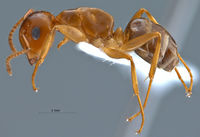Colobopsis schmitzi
| Colobopsis schmitzi | |
|---|---|

| |
| Scientific classification | |
| Kingdom: | Animalia |
| Phylum: | Arthropoda |
| Class: | Insecta |
| Order: | Hymenoptera |
| Family: | Formicidae |
| Subfamily: | Formicinae |
| Tribe: | Camponotini |
| Genus: | Colobopsis |
| Species: | C. schmitzi |
| Binomial name | |
| Colobopsis schmitzi (Stärcke, 1933) | |
Colobopsis schmitzi nests within the swollen and hollow tendrils of the carnivorous plant Nepenthes bicalcarata (Clarke and Kitching 1995, Thornham et al. 2012). These ants can move across the slippery surface of the pitcher without being trapped, and also swim in the digestive fluid where they retrieve trapped insects.
Identification
Distribution
Distribution based on Regional Taxon Lists
Indo-Australian Region: Borneo (type locality), Brunei Darussalam, Indonesia, Malaysia.
Distribution based on AntMaps
Distribution based on AntWeb specimens
Check data from AntWeb
Countries Occupied
| Number of countries occupied by this species based on AntWiki Regional Taxon Lists. In general, fewer countries occupied indicates a narrower range, while more countries indicates a more widespread species. |

|
Estimated Abundance
| Relative abundance based on number of AntMaps records per species (this species within the purple bar). Fewer records (to the left) indicates a less abundant/encountered species while more records (to the right) indicates more abundant/encountered species. |

|
Biology
The pitcher plant Nepenthes bicalcarata traps and digests almost any insect, and ants in particular, yet simultaneously houses an obligate ant partner, C. schmitzi. Nepenthes are tropical perennials whose insect traps are jug-shaped structures at the tips of their leaves, filled with liquid. C. schmitzi ants live exclusively on N. bicalcarata, where they rear their brood in the hollow pitcher tendrils. They are able to forage unharmed in the pitchers because of their unique ability to walk across the slippery trapping surfaces on the pitcher rim (Bohn & Federle 2004), and to dive and swim in the digestive fluid (Bohn et al. 2012, Clarke and Kitching 1995). This allows the ants to exploit the pitcher as a food resource, removing and consuming prey captured by their host plant, as well as harvesting extrafloral nectar produced at the slippery pitcher rim (Merbach et al. 1999).
C. schmitzi ants increase the capture efficiency of Nepenthes by keeping the pitchers’ trapping surfaces clean. The ants also reduce nutrient loss from the pitchers by predating dipteran pitcher inhabitants. Consequently, nutrients that would be otherwise lost when flies emerge and fly out become available to pitchers as ant colony waste, i.e. excreta and carcasses (Scharmann et al. 2013, Thornham et al. 2012).
Castes
Nomenclature
The following information is derived from Barry Bolton's Online Catalogue of the Ants of the World.
- schmitzi. Camponotus (Colobopsis) schmitzi Stärcke, 1933a: 29, figs. 1-13 (s.w.q.l.) BORNEO (Indonesia: Kalimantan).
- Type-material: holotype queen, 1 paratype major worker, 6 paratype minor workers, 1 paratype queen.
- Type-locality: holotype Indonesia: Borneo, Kalimantan, Poniatak Dept., Mandor (J.P. Schuitemaker); paratypes with same data.
- Type-depositories: NNML (holotype); ICVN (perhaps also NCBA, NNML) (paratypes).
- Combination in Colobopsis: Ward, Blaimer & Fisher, 2016: 350.
- Status as species: Chapman & Capco, 1951: 253; Bolton, 1995b: 122; Pfeiffer, et al. 2011: 38; McArthur, 2012: 180.
- Distribution: Indonesia (Kalimantan).
Description
References
- Bazile V, Moran JA, Le Moguédec G, Marshall DJ, Gaume L (2012) A Carnivorous Plant Fed by Its Ant Symbiont: A Unique Multi-Faceted Nutritional Mutualism. PLoS ONE 7(5): e36179.
- Bohn HF, Federle W (2004) Insect aquaplaning: Nepenthes pitcher plants capture prey with the peristome, a fully wettable water-lubricated anisotropic surface. PNAS 101: 14138–14143.
- Bohn HF, Thornham DG, Federle W (2012) Ants swimming in pitcher plants: kinematics of aquatic and terrestrial locomotion in Camponotus schmitzi. J Comp. Physiol A Neuroethol Sens Neural Behav Physiol 198: 465–476.
- Clarke C, Kitching R (1995) Swimming ants and pitcher plants: a unique ant- plant interaction from Borneo. Journal of Tropical Ecology 11: 589–602
- Fernandes, G.W., de Castro, F.S., Camarota, F., Blum, J.C., Maia, R. 2021. Ant rafting in an extreme ecosystem. Sociobiology, 68(4), e7430 (doi:10.13102/sociobiology.v68i4.7430).
- Merbach MA, Zizka G, Fiala B, Merbach D, Maschwitz U (1999) Giant nectaries in the peristome thorns of the pitcher plant Nepenthes bicalcarata Hook f. (Nepenthaceae): Anatomy and functional aspects. Ecotropica 5: 45–50.
- Scharmann M, Thornham DG, Grafe TU, Federle W (2013) A Novel Type of Nutritional Ant–Plant Interaction: Ant Partners of Carnivorous Pitcher Plants Prevent Nutrient Export by Dipteran Pitcher Infauna. PLoS ONE 8(5): e63556.
- Stärcke, A. 1933a. Contribution à l'étude de la faune népenthicole. Art. III. Un nouveau Camponotus de Bornéo, habitant les tiges creuses de Nepenthes, récolté par J. P. Schuitemaker. Natuurhist. Maandbl. 22: 29-31 (page 29, figs. 1-6 soldier, worker, queen, larva described)
- Thornham DG, Smith JM, Grafe TU, Federle W (2012) Setting the trap: cleaning behaviour of Camponotus schmitzi ants increases long-term capture efficiency of their pitcher plant host, Nepenthes bicalcarata. Funct Ecol 26: 11–19.
- Ward, P.S., Blaimer, B.B., Fisher, B.L. 2016. A revised phylogenetic classification of the ant subfamily Formicinae (Hymenoptera: Formicidae), with resurrection of the genera Colobopsis and Dinomyrmex. Zootaxa 4072 (3): 343–357 (doi:10.11646/zootaxa.4072.3.4).
References based on Global Ant Biodiversity Informatics
- Chapman, J. W., and Capco, S. R. 1951. Check list of the ants (Hymenoptera: Formicidae) of Asia. Monogr. Inst. Sci. Technol. Manila 1: 1-327
- Pfeiffer M.; Mezger, D.; Hosoishi, S.; Bakhtiar, E. Y.; Kohout, R. J. 2011. The Formicidae of Borneo (Insecta: Hymenoptera): a preliminary species list. Asian Myrmecology 4:9-58


